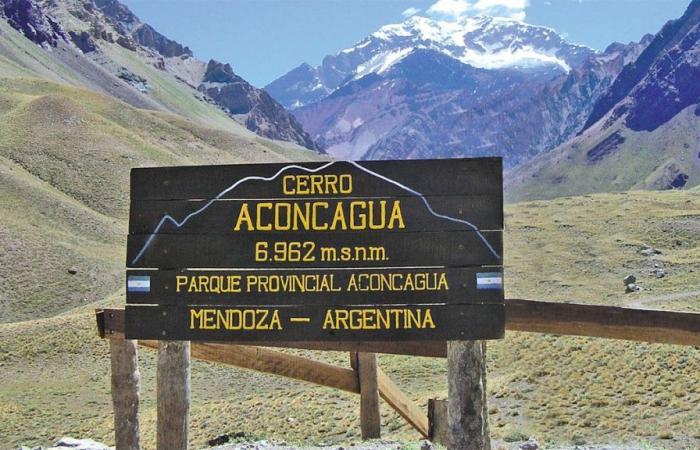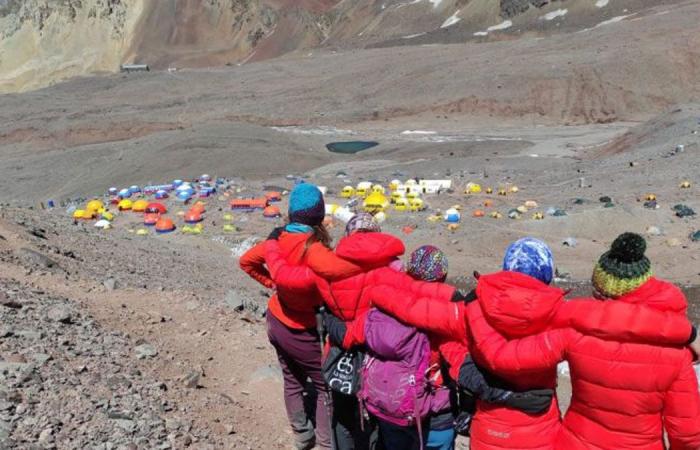►YOU MAY BE INTERESTED: The New York Times published a special with a mysterious discovery of two Mendoza residents in Aconcagua
lombardi latorre reynoso aconcagua.jpg
Andrés Lombardi, Jimena Latorre and Marcelo Reynoso.
The law that is sought to be updated is No. 5,463 with the goal of improve environmental and tourism managementthe ministry said.
“With this project we are updating a standard that dates back to 1989. This will allow us to have a better and more adequate management and handling plan for resources, the environment and the developments that can be carried out within Aconcagua Park“Latorre commented.
Latorre speeds up the treatment of the Aconcagua law in the Legislature
The minister, who presented the project in Deputies, He asked lawmakers to move forward with treatment and approval as soon as possible.: “The opening season of the park requires us to have this icon in good condition and hence the request to the Legislature for its rapid treatment.”
As he explained, the new law will allow “services to be concessioned and the private companies to be the ones to create the necessary and permitted infrastructure.” You cannot talk about works, said the minister. In the area in question, non-fixed structures will be built, which adapt to the needs and interests of the businesses and activities to be developed.
The reforms will also be applied on Route 7 and in the surrounding communities, the official said. To this end, agreements are expected to be signed with the Municipality of Las Heras for the concession of 13 buildings located in the town of Las Cuevas.
Reynoso also clarified that “the area of controlled use is minimal”; that is to say that “the entire surface of the Park will not be affected, which is fundamental for the oases of the province”.
During the presentation, Minister Latorre assured that “this zoning implies being able to determine precisely what the intangible zones, restricted zones, controlled use zones and special controlled use zones are in order to be able to provide the services of security that corresponds, both for providers and for users.
For his part, the director of Tourism Development and Innovation added that “for the Mendoza Tourism Entity, the promulgation of the new zoning is of great importance because Mendoza is betting on new perspectives for the development of tourism activities. hiking and trekking“, as is the case in the rest of the world.
This redevelopment “would allow the opening of spaces and activities within the main protected natural area of Mendoza, which is Aconcagua,” he stressed.
Aconcagua Provincial Park
The reality of the Aconcagua Provincial Park has changed substantially since the enactment of Law 5,463, which zoned the natural area in 1989. Currently, it requires management tools that allow not only public use but also the establishment of sustainable development of the ecological heritage through a management plan, according to the conception of the current conservation paradigm in the world.
The zoning of a protected natural area is a programmatic aspect within the framework of a comprehensive management plan, which is approved by the implementing authority through a legal regulation.
In this sense, zoning consists of a functional subdivision that orders the use of space based on the conservation objectives of the protected area. It is an irreplaceable component of the management plan, since it constitutes the spatial planning framework to which the projects and activities programmed in the plan and the uses permitted within the protected area must be subject.
photo-aconcagua-female-750×440.jpg
The zoning will define, depending on the capacity of that territory (the protected area and its surroundings), different uses, activities and desired conditions, fundamentally depending on the scope of the conservation objectives with which the park was created. During the development process, physical, biological, ecological, cultural, legal, institutional and operational factors were taken into account to develop the work.
This new zoning will allow us to effectively articulate the conservation of the natural heritage of our province and the development of public use activities linked to nature tourism, strengthening our Aconcagua Park as a pole for generating sustainable development for local communities and the province of Mendoza.
Regulatory basis and participation of different actors
The development of this project is framed in Law 6,045 on Protected Natural Areas; Law 4,807 on the creation of the Aconcagua Provincial Park; Law 5,463 on Primary Zoning of the Aconcagua Provincial Park; Law 6,955 on Natural Monuments; Law 8,051 on Territorial Planning and Law 8,999 Territorial Planning Plan of the province; Law 6,034 on the Protection of Cultural Heritage; National Law 26,639 on the Preservation of Glaciers and the Periglacial Environment and National Law 24,375 on the approval of the Convention on Biological Diversity.
In addition, social and institutional participation was incorporated into the process through the Permanent Advisory Commission of Aconcagua Park (CAPPA). It is made up of organizations and institutions directly linked to the protected area. These organizations are scientific and academic institutions such as the CCT Mendoza (Iadiza, Ianigla, Incihusa, UNCuyo, Interdisciplinary Institute of Basic Sciences), public technical institutions and operators of services tendered by the Enforcement Authority (Segemar, Heritage Directorate, Medical Service and Air Service of the Park), public management institutions (Municipality of Las Heras, Emetur, UPRAM Rescue Patrol), service providers and individuals and legal entities that carry out activities in the area, and civil society organizations.







